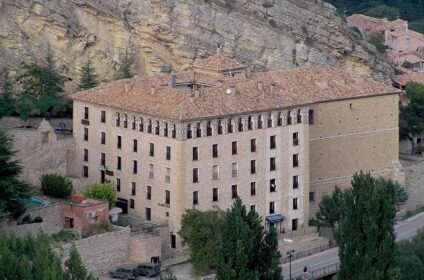Colegio de Escolapios
Descripción
La ciudad de Albarracín se encontraba en el siglo XVIII muy alejada del centro político del país y al margen de la influencia aristócrata. De este modo, fueron los obispos de Albarracín los encargados de promover una serie de obras que, bajo el ideal reformista de la Ilustración, contribuyeron a mejorar la realidad social de la ciudad. Así, en 1742, durante el obispado de Juan Francisco Navarro, los padres Escolapios iniciaron las obras del colegio de Escolapios, una edificación de considerables dimensiones destinada a la enseñanza y formación de la juventud del territorio. Su estructura destaca por su planta cuadrada dispuesta torno a un patio interior que sirve de distribuidor de las aulas y dormitorios de los frailes y escolares.
Los austeros muros exteriores de mampostería rompen la monotonía gracias al empleo de bandas de ladrillo en su fachada principal y al enlucido de yeso policromado de la última planta. El edificio aparece además rematado por una torre lucernario que ilumina la escalera. El imponente acceso principal por la carretera de Teruel se efectúa desde la cuarta planta, contando sobre este nivel con dos plantas más de las que podemos resaltar, como es habitual en las edificaciones aragonesas de este periodo, la última, resuelta a modo de galería de arcos de medio punto bajo prominente alero.
A pesar de su función inicial también el edificio fue empleado temporalmente como seminario para la formación de los frailes escolapios, albergando además por breve tiempo la Facultad de Ciencias Exactas y Físico-Naturales para religiosos. En la actualidad funciona como hotel.
Description
In the 18th century, the city of Albarracín was very far from the political center of the country and outside of aristocratic influence. In this way, the bishops of Albarracín were responsible for promoting a series of works that, under the reformist ideal of the Enlightenment, contributed to improving the social reality of the city. Thus, in 1742, during the bishopric of Juan Francisco Navarro, the Escolapios fathers began the work of the Escolapios school, a building of considerable dimensions intended for the teaching and training of the youth of the territory. Its structure stands out for its square floor plan arranged around an interior patio that serves as a distributor for the classrooms and bedrooms of the friars and schoolchildren.
The austere exterior masonry walls break the monotony thanks to the use of brick bands on its main façade and the polychrome plaster plastering of the top floor. The building is also topped by a skylight tower that illuminates the staircase. The imposing main access along the Teruel highway is from the fourth floor, with two more floors on this level of which we can highlight, as is usual in Aragonese buildings of this period, the last one, resolved as a gallery of semicircular arches under prominent eaves.
Despite its initial function, the building was also temporarily used as a seminary for the training of Piarist friars, also briefly housing the Faculty of Exact and Physical-Natural Sciences for religious. It currently operates as a hotel.
- Dirección: 44126 Albarracín, Teruel, España
